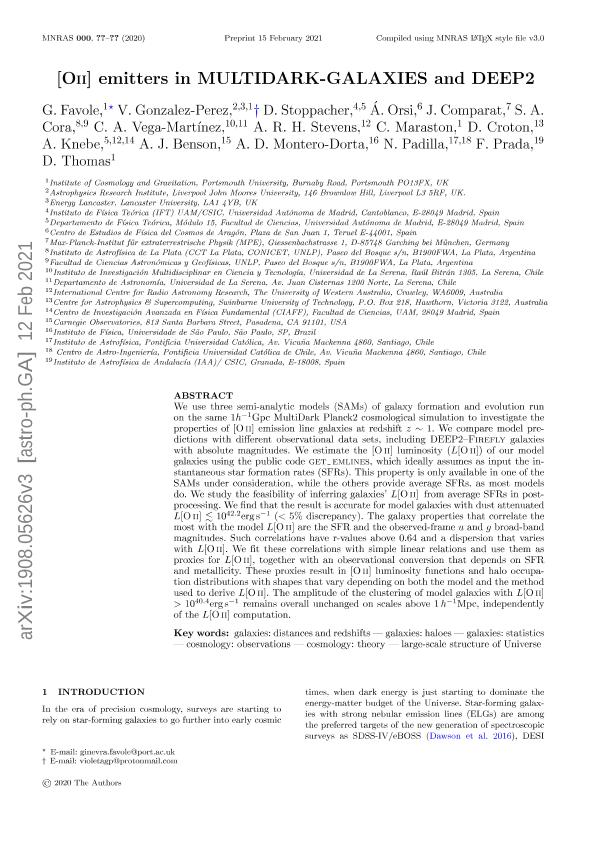Mostrar el registro sencillo del ítem
dc.contributor.author
Favole, G
dc.contributor.author
González Pérez, Carlos Federico

dc.contributor.author
Stoppacher, D
dc.contributor.author
Orsi, Á
dc.contributor.author
Comparat, J
dc.contributor.author
Cora, Sofia Alejandra

dc.contributor.author
Vega Martínez, Cristian Antonio

dc.contributor.author
Stevens, A. R. H.
dc.contributor.author
Maraston, C.
dc.contributor.author
Croton, D.
dc.contributor.author
Knebe, A.
dc.contributor.author
Benson, Silvia

dc.contributor.author
Montero Dorta, A. D.
dc.contributor.author
Padilla, Natalia Soledad

dc.contributor.author
Prada, Federico

dc.contributor.author
Thomas, Pablo Daniel

dc.date.available
2021-11-26T17:13:11Z
dc.date.issued
2020-10
dc.identifier.citation
Favole, G; González Pérez, Carlos Federico; Stoppacher, D; Orsi, Á; Comparat, J; et al.; [O ii] emitters in MultiDark-Galaxies and DEEP2; Wiley Blackwell Publishing, Inc; Monthly Notices of the Royal Astronomical Society; 497; 4; 10-2020; 5432-5453
dc.identifier.issn
0035-8711
dc.identifier.uri
http://hdl.handle.net/11336/147534
dc.description.abstract
We use three semi-analytical models (SAMs) of galaxy formation and evolution run on the same 1 h−1 Gpc MultiDark Planck2 cosmological simulation to investigate the properties of [O II] emission line galaxies at redshift z ∼ 1. We compare model predictions with different observational data sets, including DEEP2–FIREFLY galaxies with absolute magnitudes. We estimate the [O II] luminosity (L[O II]) of our model galaxies using the public code GET EMLINES , which ideally assumes as input the instantaneous star formation rates (SFRs). This property is only available in one of the SAMs under consideration, while the others provide average SFRs, as most models do. We study the feasibility of inferring galaxies’ L[O II] from average SFRs in post-processing. We find that the result is accurate for model galaxies with dust attenuated L[O II] 1042.2 erg s−1 (< 5 per cent discrepancy). The galaxy properties that correlate the most with the model L[O II] are the SFR and the observed-frame u and g broad-band magnitudes. Such correlations have r-values above 0.64 and a dispersion that varies with L[O II] . We fit these correlations with simple linear relations and use them as proxies for L[O II] , together with an observational conversion that depends on SFR and metallicity. These proxies result in [O II] luminosity functions and halo occupation distributions with shapes that vary depending on both the model and the method used to derive L[O II] . The amplitude of the clustering of model galaxies with L[O II] >1040.4 erg s−1 remains overall unchanged on scales above 1 h−1 Mpc, independently of the L[O II] computation.
dc.format
application/pdf
dc.language.iso
eng
dc.publisher
Wiley Blackwell Publishing, Inc

dc.rights
info:eu-repo/semantics/openAccess
dc.rights.uri
https://creativecommons.org/licenses/by-nc-sa/2.5/ar/
dc.subject
galaxies: distances and redshifts
dc.subject
galaxies: haloes
dc.subject
galaxies: statistics
dc.subject
large-scale structure of Universe
dc.subject
cosmology: observations
dc.subject
cosmology: theory
dc.subject.classification
Astronomía

dc.subject.classification
Ciencias Físicas

dc.subject.classification
CIENCIAS NATURALES Y EXACTAS

dc.title
[O ii] emitters in MultiDark-Galaxies and DEEP2
dc.type
info:eu-repo/semantics/article
dc.type
info:ar-repo/semantics/artículo
dc.type
info:eu-repo/semantics/publishedVersion
dc.date.updated
2021-07-01T15:01:29Z
dc.journal.volume
497
dc.journal.number
4
dc.journal.pagination
5432-5453
dc.journal.pais
Reino Unido

dc.description.fil
Fil: Favole, G. Institute Of Cosmology And Gravitation; Reino Unido
dc.description.fil
Fil: González Pérez, Carlos Federico. Institute Of Cosmology And Gravitation; Reino Unido
dc.description.fil
Fil: Stoppacher, D. Universidad Autónoma de Madrid; España
dc.description.fil
Fil: Orsi, Á. Centro de Estudios de Fisica del Cosmos de Aragon; España
dc.description.fil
Fil: Comparat, J. Max-planck-institut F¨ur Extraterrestrische Physik; Alemania
dc.description.fil
Fil: Cora, Sofia Alejandra. Consejo Nacional de Investigaciones Científicas y Técnicas. Centro Científico Tecnológico Conicet - La Plata. Instituto de Astrofísica La Plata. Universidad Nacional de La Plata. Facultad de Ciencias Astronómicas y Geofísicas. Instituto de Astrofísica La Plata; Argentina
dc.description.fil
Fil: Vega Martínez, Cristian Antonio. Universidad de La Serena; Chile
dc.description.fil
Fil: Stevens, A. R. H.. International Centre For Radio Astronomy Research; Australia
dc.description.fil
Fil: Maraston, C.. Institute Of Cosmology And Gravitation; Reino Unido
dc.description.fil
Fil: Croton, D.. Centre For Astrophysics And Supercomputing, Swinburne; Australia
dc.description.fil
Fil: Knebe, A.. Departamento de Física Teórica, Universidad Autónoma D; España
dc.description.fil
Fil: Benson, Silvia. Carnegie Observatories; Estados Unidos
dc.description.fil
Fil: Montero Dorta, A. D.. Univesidad de Sao Paulo; Brasil
dc.description.fil
Fil: Padilla, Natalia Soledad. Pontificia Universidad Católica de Chile; Chile
dc.description.fil
Fil: Prada, Federico. Instituto de Astrofísica de Andalucía; España
dc.description.fil
Fil: Thomas, Pablo Daniel. Institute Of Cosmology And Gravitation; Reino Unido
dc.journal.title
Monthly Notices of the Royal Astronomical Society

dc.relation.alternativeid
info:eu-repo/semantics/altIdentifier/url/https://academic.oup.com/mnras/article/497/4/5432/5881340
dc.relation.alternativeid
info:eu-repo/semantics/altIdentifier/doi/http://dx.doi.org/10.1093/mnras/staa2292
Archivos asociados
